Safety Assessment for Upper Part of Floating Crane Considering Minimum Luffing Angle
Abstract
:1. Introduction
2. Minimized Design of Luffing Angle
2.1. Specification Analysis on Marine Bridge and Floating Crane
2.2. Target Crane and Additional Consideration by Minimized Luffing Angle
3. Load Condition and Modeling for Structural Analysis
3.1. Load Conditions
3.1.1. Load Conditions for Boom
3.1.2. Load Conditions for Back Tower
3.2. Combined Load
3.2.1. Combined Load for Boom
3.2.2. Combined Load for Back Tower
3.3. Modeling and Boundary Condition
4. Consideration and Discussion of Structure Analysis Result
4.1. Deformation by Applied Load
4.2. Allowable Stress Setting and Stress Assessment
- -
- Safety factor 1.5 for crane working without wind (Case I)
- -
- Safety factor 1.33 for crane working with wind (Case II)
- -
- Safety factor 1.10 for crane subjected to exceptional loadings (Case III).
4.3. Assessment Result of Buckling Stress
4.4. Discussion and Limitations
5. Conclusions
- (1)
- The floating crane has been designed by reflecting the minimum luffing angle, which has considered the movement on the sea. Additionally, from the result of structural analysis on the boom, back tower, and support members under the luffing condition, high reaction force and fatigue may be increased in the boom closer to the horizontal angle. As the additional load of a hydraulic cylinder is applied, which is used for the recovery of luffing angle in the service condition, it has been found out that the process of an assessment on the structural stress must be considered.
- (2)
- From the result of a review from the aspect of allowable stress, deformation, and buckling with the application of KR rules to the designed floating crane, it has been evaluated such that overall safety was secured. As shown from the results of Section 4.2, the stress occurred in the luffing condition has shown the same stress level as that in the service condition. The deformation of the boom covered in Section 4.1 has shown the highest in the service condition, and the deformation of the back tower has shown the highest in the luffing condition. In addition, the reaction force increased in the upper part of the boom and the support in the luffing condition. The compression force increased at the center of the boom, but buckling did not occur from the result of an assessment.
- (3)
- According to Section 2.2, the number of marine bridges listed in Table 1 that can pass through it has increased very significantly if the boom height is reduced to the level of the back tower by lowering the minimum luffing angle in case of 2200 ton and 3000 ton cranes. This means that the utilization rate of the crane can be increased, and it is a great advantage for the operating company. In addition, the estimation of the reaction force in the boom-connecting wire in the minimum luffing condition and the load combination including luffing condition and procedure for safety assessment performed in this study can be applied to a large crane (about up to 4000 tons class) with a barge or monohull as a lower hull.
Author Contributions
Funding
Institutional Review Board Statement
Informed Consent Statement
Data Availability Statement
Conflicts of Interest
References
- Ministry of Employment and Labor (MOEL). Safety Inspection Notice, 2020; No. 2020-43; MOEL: Seoul, Korea, 2020.
- Shepherd, G.; Kahler, R.; Cross, J. Crane fatalities—A taxonomic analysis. Saf. Sci. 2000, 36, 83–93. [Google Scholar] [CrossRef]
- King, A. Analysis of Crane and Lifting Accidents in North America from 2004 to 2010. University of Texas, USA. 2012. Available online: https://dspace.mit.edu/handle/1721.1/73792 (accessed on 10 May 2021).
- Milazzo, M.F.; Ancione, G.; Spasojevic Brkic, V.; Vališ, D. Investigation of crane operation safety by analysing main accident causes. In Risk, Reliability and Safety: Innovating Theory and Practice, Proceedings of the 26th European Safety and Reliability Conference, ESREL 2016, Glasgow, Scotland, 25–29 September 2016; Walls, L., Revie, M., Bedford, T., Eds.; CRC Press/Balkema: London, UK, 2017; p. 15. Available online: https://www.researchgate.net/publication/311439947 (accessed on 10 May 2021).
- Aneziris, O.; Papazoglou, I.; Mud, M.; Damen, M.; Kuiper, J.; Baksteen, H.; Ale, B.; Bellamy, L.; Hale, A.; Bloemhoff, A.; et al. Towards risk assessment for crane activities. Saf. Sci. 2008, 46, 872–884. [Google Scholar] [CrossRef]
- Ancione, G.; Paltrinieri, N.; Milazzo, M.F. Integrating Real-Time Monitoring Data in Risk Assessment for Crane Related Offshore Operations. J. Mar. Sci. Eng. 2020, 8, 532. [Google Scholar] [CrossRef]
- Milazzo, M.; Ancione, G.; Consolo, G. Human Factors Modelling Approach: Application to a Safety Device Supporting Crane Operations in Major Hazard Industries. Sustainability 2021, 13, 2304. [Google Scholar] [CrossRef]
- Lingard, H.; Cooke, T.; Zelic, G.; Harley, J. A qualitative analysis of crane safety incident causation in the Australian construction industry. Saf. Sci. 2021, 133, 105028. [Google Scholar] [CrossRef]
- Cha, J.-H.; Park, K.-P.; Lee, K.-Y. Numerical Analysis for Nonlinear Static and Dynamic Responses of Floating Crane with Elastic Boom. Trans. Korean Soc. Mech. Eng. A 2010, 34, 501–509. [Google Scholar] [CrossRef]
- Hong, J.W.; Roh, M.I.; Ham, S.H.; Ha, S. Dynamic simulation of subsea equipment installation using offshore support vessel based on flexible multibody system dynamics. J. Mar. Sci. Technol. 2016, 24, 807–821. Available online: http://jmst.ntou.edu.tw/marine/24-4/807-821.pdf (accessed on 10 May 2021).
- Sun, Y.G.; Qiang, H.Y.; Xu, J.; Dong, D.S. The nonlinear dynamics and anti-sway tracking control for offshore container crane on a mobile harbor. J. Mar. Sci. Technol. 2017, 25, 656–665. Available online: https://jmst.ntou.edu.tw/marine/25-6/656-665.pdf (accessed on 10 May 2021).
- Yang, X.R.; Gan, Q.M.; Wang, Y.H.; Zhou, Y.B. Dynamic reliability analysis of the crane ship lifting load system. J. Mar. Sci. Technol. 2017, 25, 552–562. Available online: https://jmst.ntou.edu.tw/marine/25-5/552-562.pdf (accessed on 10 May 2021).
- Yang, X.R.; Gan, Q.M.; Wang, Y.H.; Wang, G.D. Dynamic response analysis of the lifting load system of a crane ship in irregular waves. J. Mar. Sci. Technol. 2019, 27, 481–497. Available online: https://jmst.ntou.edu.tw/marine/27-6/481-497.pdf (accessed on 10 May 2021).
- Nam, M.; Kim, J.; Lee, J.; Kim, D.; Lee, D.; Lee, J. Cooperative control system of the floating cranes for the dual lifting. Int. J. Nav. Arch. Ocean Eng. 2018, 10, 95–102. [Google Scholar] [CrossRef]
- Cha, J.-H.; Park, K.-P.; Lee, K.-Y. Development of a simulation framework and applications to new production processes in shipyards. Comput. Des. 2012, 44, 241–252. [Google Scholar] [CrossRef]
- Bae, J.; Cha, J.; Seo, M.-G.; Lee, K.; Lee, J.; Ku, N. Experimental Study on Development of Mooring Simulator for Multi Floating Cranes. J. Mar. Sci. Eng. 2021, 9, 344. [Google Scholar] [CrossRef]
- Park, C.H.; Kim, B.W.; Ha, M.K.; Chun, M.S. A basic structural design for large floating crane. J. Ocean Eng. Technol. 2005, 19, 71–76. Available online: https://www.joet.org/journal/view.php?number=2597 (accessed on 10 May 2021).
- Kang, Y.G.; Beak, S.H.; Lee, J.H.; Park, W.J.; Sim, D.S.; An, Y.T.; Cho, P.S. The hull strength assessment for heavy lift floating crane. Soc. Nav. Archit. Korea 2015, 9, 1–8. Available online: https://www.koreascience.or.kr/article/CFKO201522355580734.pdf (accessed on 10 May 2021).
- Choi, H.C.; Kim, S.W. A Study on the safe maneuvering of group towing for floating crane. In Proceedings of the Autumn Annual Conference for Korean Institute of Navigation and Port Research, Pusan, Korea, 21–23 October 2010; pp. 38–39. [Google Scholar]
- Sun, G.; Liu, J. Dynamic responses of hydraulic crane during luffing motion. Mech. Mach. Theory 2006, 41, 1273–1288. [Google Scholar] [CrossRef]
- Lee, M.J.; Han, D.S.; Han, G.J. Evaluation of Structural Stability of Jib Crane for A Feed Vessel According to the Luffing Angle. J. Korea Soc. Power Syst. Eng. 2008, 12, 24–28. Available online: https://www.koreascience.or.kr/article/JAKO200806942469751.pdf (accessed on 10 May 2021).
- Zhou, Q.C.; Li, W.J.; Wu, Q.L.; Xiong, X.L. Nonlinear Calculating Method for Multi-Bar Luffing System of Giant Crane Considering the Sagging Effect. Appl. Mech. Mater. 2013, 477–478, 307–314. [Google Scholar] [CrossRef]
- Song, J.W.; Lee, Y.S.; Jeong, M.; Jo, I.S. Analysis of major specifications of domestic marine bridges. In Proceedings of the Autumn Annual Conference for the Korean Institute of Navigation and Port Research, Pusan, Korea, 5–6 December 2007; pp. 266–268. [Google Scholar]
- Available online: https://en.wikipedia.org/wiki/SSCV_Sleipnir (accessed on 10 May 2021).
- Available online: https://en.wikipedia.org/wiki/Crane_vessel (accessed on 10 May 2021).
- Lee, M.J.; Han, D.S.; Lee, S.W.; Han, G.J. Analysis of Reaction Force of Jib Crane for Shipment According to Luffing Angle. In Proceedings of the Korean Society of Precision Engineering Conference, Jeju, Korea, 20–22 June 2007; pp. 527–528. Available online: https://www.koreascience.or.kr/article/CFKO200717054765322.pdf (accessed on 29 May 2021).
- Korea Register of Shipping. Rules for the Classification of Steel Ships; Pt. 9, Ch. 2, Sec. 4—Crane; Korea Register of Shipping: Busan, Korea, 2014. [Google Scholar]
- Kim, M.-S.; Lee, J.-C.; Jeong, S.-Y.; Ahn, S.-H.; Son, J.-W.; Cho, K.-J.; Song, C.-K.; Park, S.-R.; Bae, T.-H. Structure Evaluation for the Level Luffing Crane’ Boom. Trans. Korean Soc. Mech. Eng. A 2008, 32, 526–532. [Google Scholar] [CrossRef] [Green Version]
- American Bureau of Shipping. Guide for Certification of Lifting Appliances; American Bureau of Shipping: Houston, TX, USA, 2020; p. 37. [Google Scholar]
- DNVGL-ST-0378. Standard for Offshore and Platform Lifting Appliances; DNVGL: Baerum, Norway, 2016; Chapter 4.3. [Google Scholar]
- American Bureau of Shipping. Guide for Buckling and Ultimate Strength Assessment for Offshore Structures; American Bureau of Shipping: Houston, TX, USA, 2018; p. 27. [Google Scholar]
- Sun, H.-H.; Spencer, J. Buckling strength assessment of corrugated panels in offshore structures. Mar. Struct. 2005, 18, 548–565. [Google Scholar] [CrossRef]
- Sun, H.-H.; Tan, P.-L. Background of ABS Buckling Strength Assessment Criteria for Cylindrical Shells in Offshore Structures. J. Offshore Mech. Arct. Eng. 2008, 130, 021012. [Google Scholar] [CrossRef] [Green Version]
- ABS. Rules for Building and Classing Offshore Mobile Drilling Unit; American Bureau of Shipping: Houston, TX, USA, 2006. [Google Scholar]
- ABS. Guide for Building and Classing Floating Production Installations; American Bureau of Shipping: Houston, TX, USA, 2004. [Google Scholar]
- Rahman, M.M.; Kamol, R.S.; Islam, R. Structural analysis of a ship on global aspect using ANSYS. In Proceedings of the 1st International Conference on Mechanical Engineering and Applied Science (ICMEAS 2017), Dhaka, Bangladesh, 22–23 February 2017; p. 020008. [Google Scholar]
- Wang, E.D.; Bone, J.S.; Ma, M.; Dinovitzer, A. Guidelines for Evaluation of Marine Finite Elements Analyses; Report No. SSC-475; Ship Structure Committee: Washington, DC, USA, 2019; Available online: http://www.shipstructure.org/pdf/475.pdf (accessed on 10 May 2021).
- Kim, T.Y.; Yoon, S.W.; Cho, J.H.; Jung, S.H.; Kim, M.H. Direct strength assessment of pure car and truck carrier under maximum cargo loads. J. Ocean Eng. Technol. 2019, 33, 641–647. (In Korean) [Google Scholar] [CrossRef] [Green Version]
- Kim, B.-S.; Hwang, H.-G.; Yoon, S.-W.; Kim, T.-Y.; Kang, J.-L. Development of Transporter for Marine Leisure Ship with Safety and Operation Support System. J. Ocean Eng. Technol. 2019, 33, 486–494. [Google Scholar] [CrossRef]
- Lim, J.H.; Jo, H.J. Prediction of Barge Ship Roll Response Amplitude Operator Using Machine Learning Techniques. J. Ocean Eng. Technol. 2020, 34, 167–179. [Google Scholar] [CrossRef]
- Kim, K.S.; Yoon, K.Y.; Jang, Y.S. Evaluation for Structural Safety of Offshore Structures under Accidental Loads. Comput. Struct. Eng. 2010, 23, 34–42. Available online: http://www.koreascience.kr/article/JAKO201029848350559.pdf (accessed on 10 May 2021). (In Korean).
- Ventikos, N.P.; Koimtzoglou, A.; Louzis, K.; Eliopoulou, E. Statistics for marine accidents in adverse weather conditions. In Maritime Technology and Engineering; Soares, C.G., Santos, T.A., Eds.; CRC Press: London, UK, 2014. [Google Scholar]
- Pedersen, P.T.; Chen, J.; Zhu, L. Design of bridges against ship collisions. Mar. Struct. 2020, 74, 102810. [Google Scholar] [CrossRef]
- Bae Ship Collision Risk Assessment and Sensitivity Analysis for Sea-crossing Bridges. J. Korean Soc. Civ. Eng. 2013, 33. [CrossRef] [Green Version]
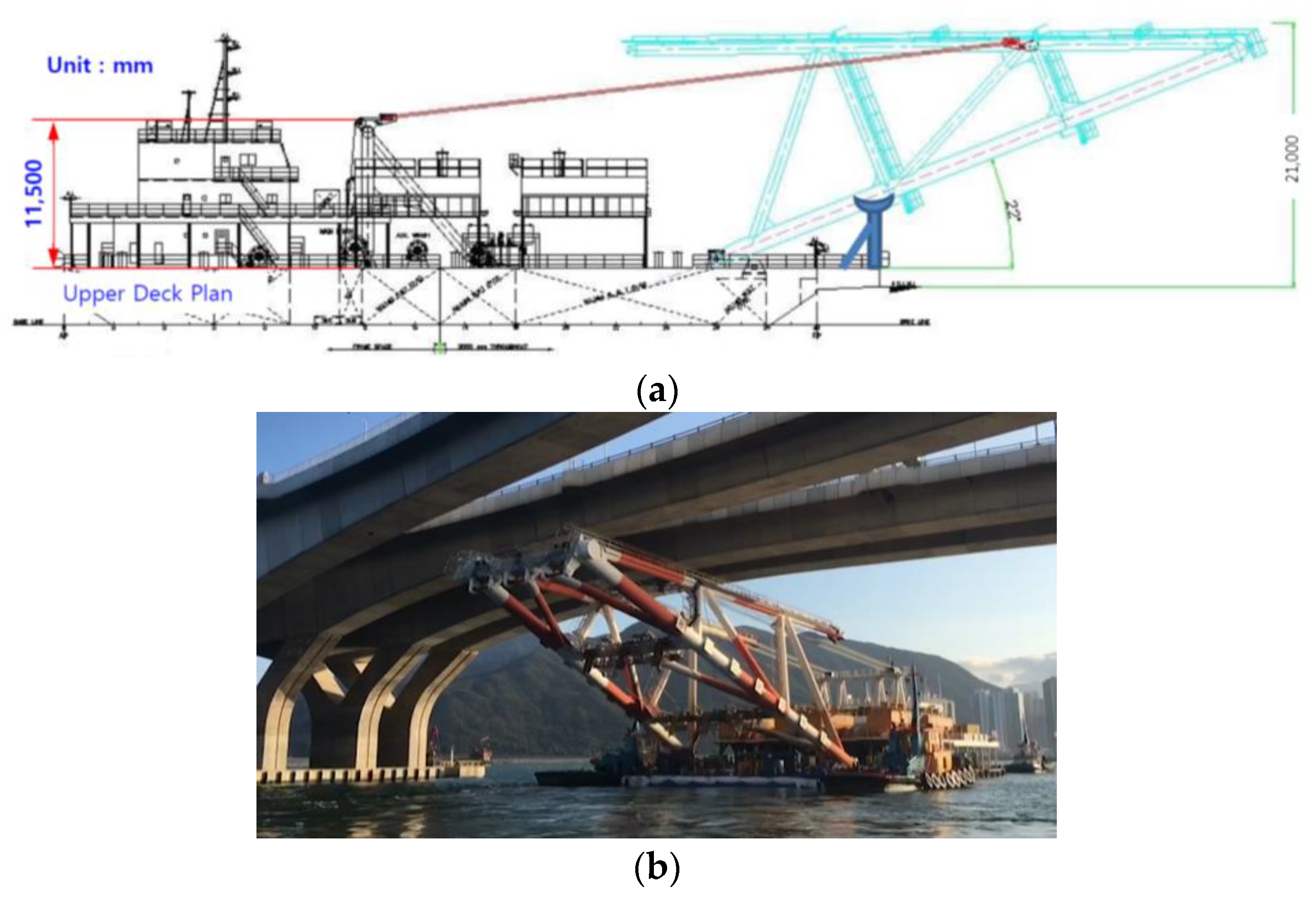
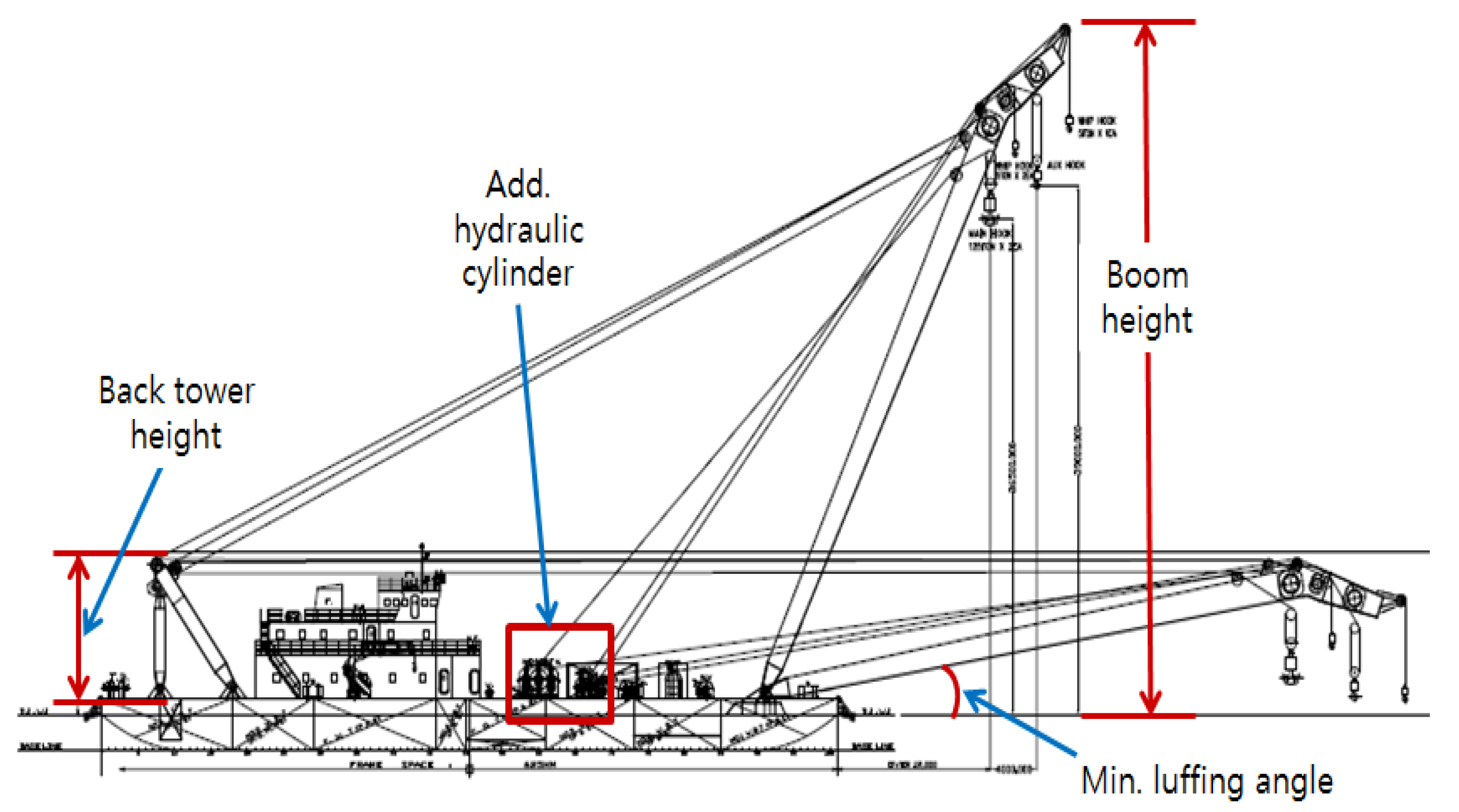



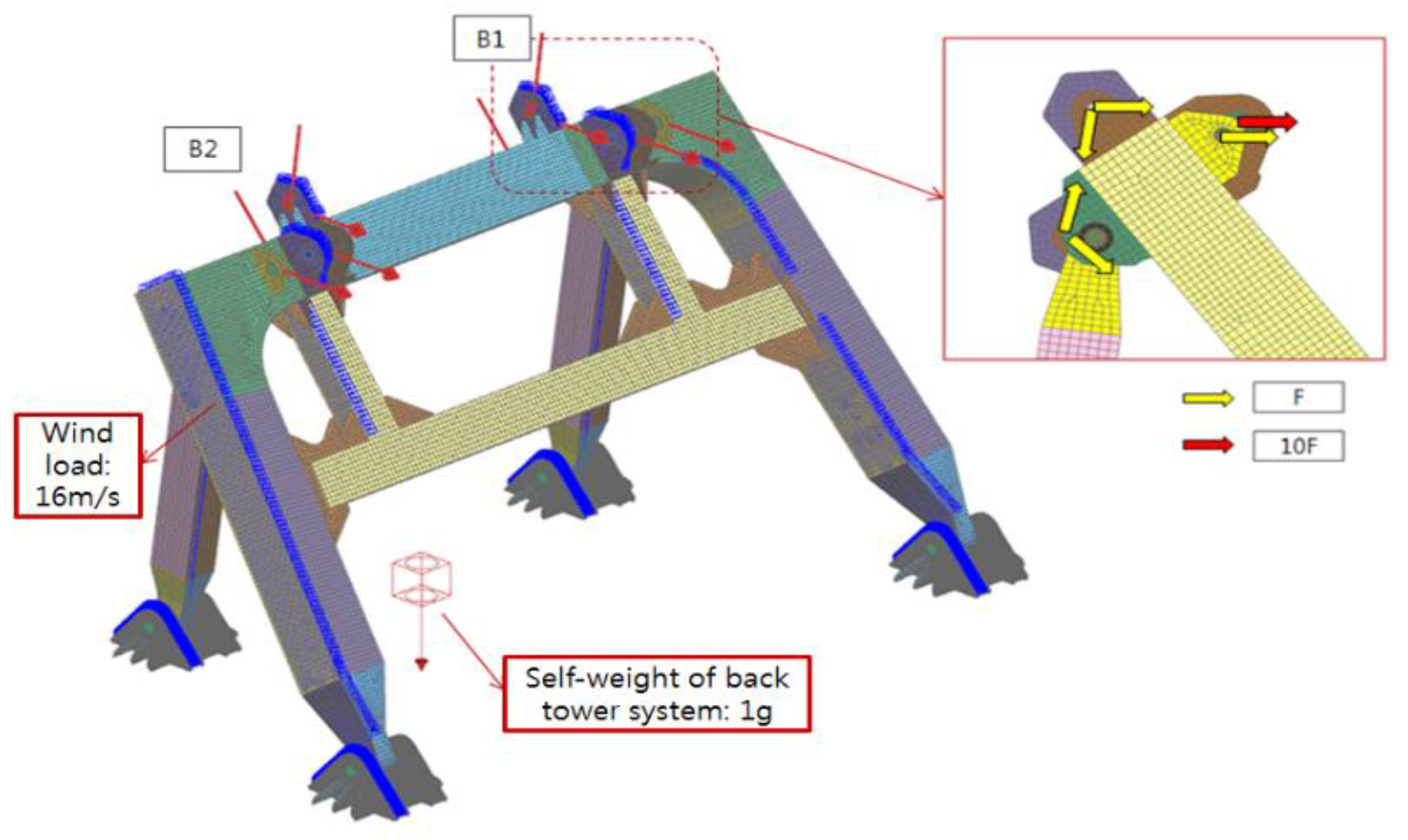
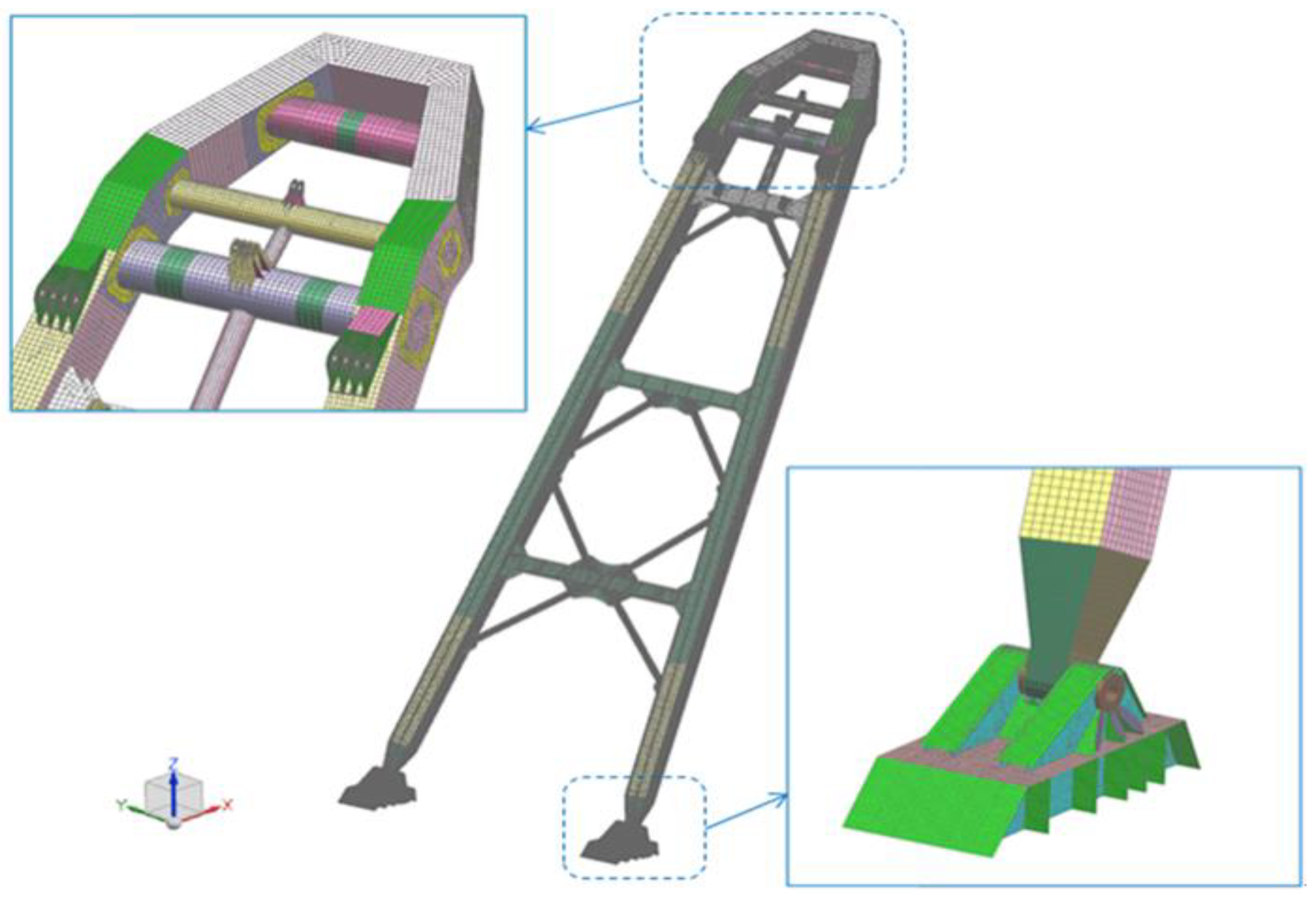
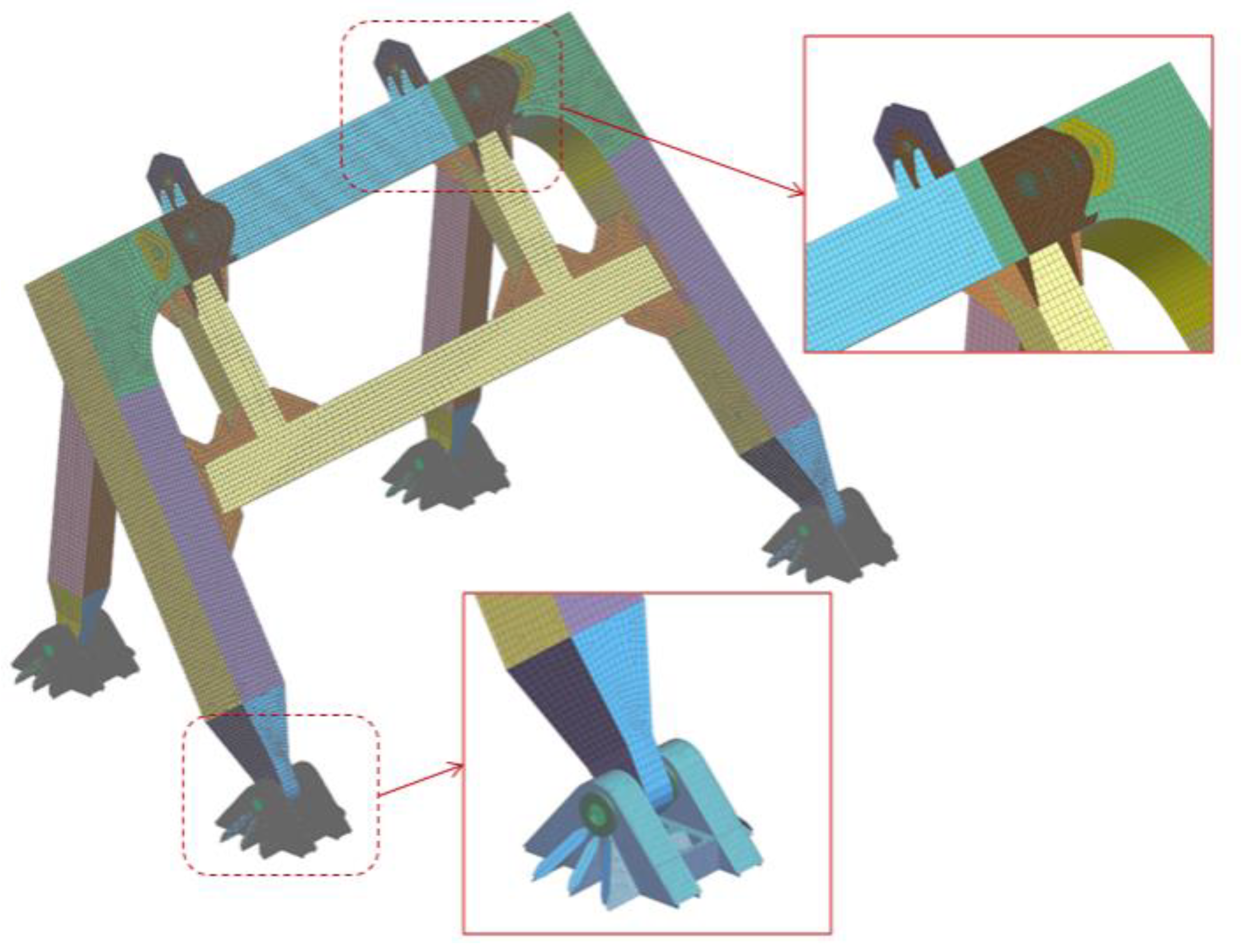


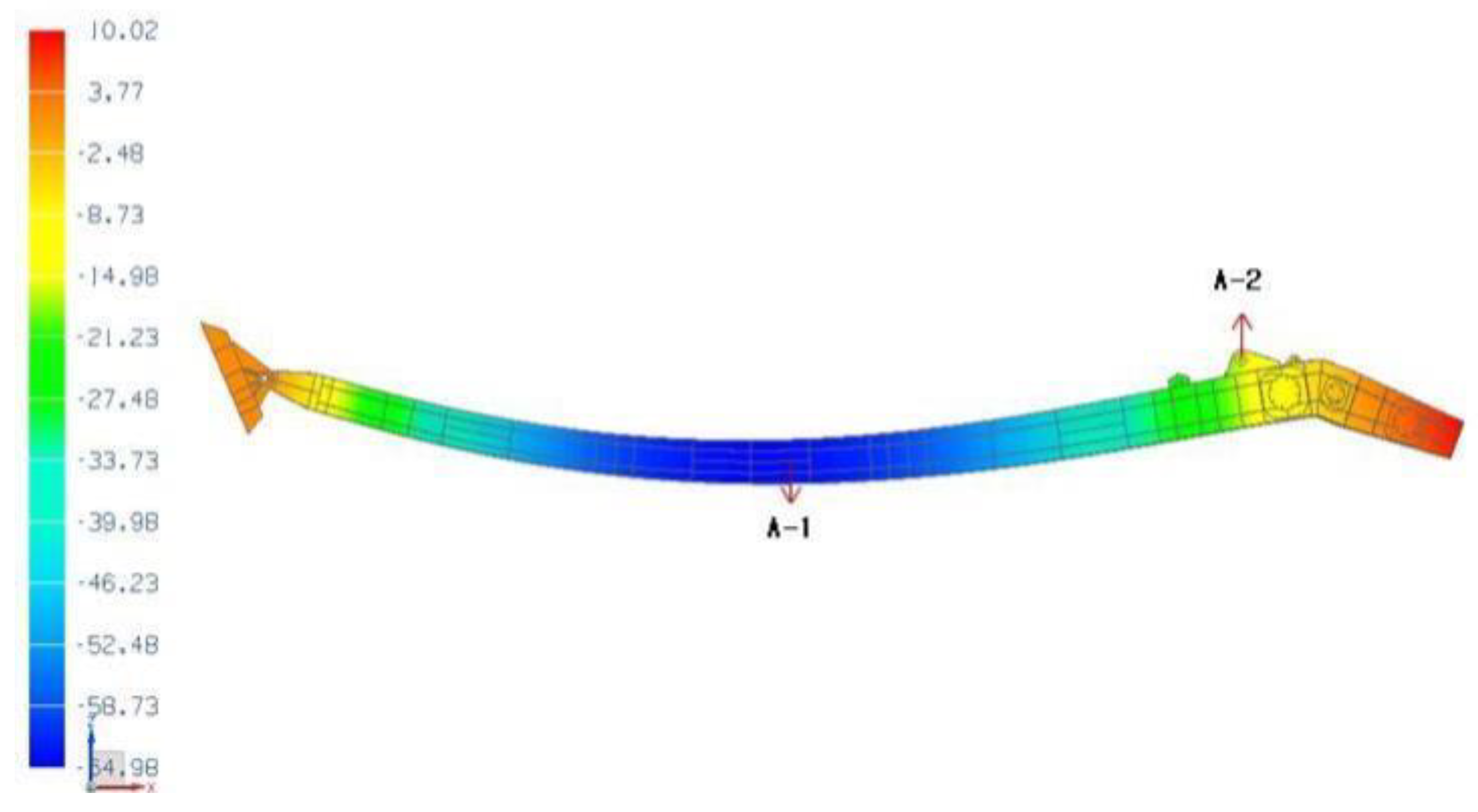
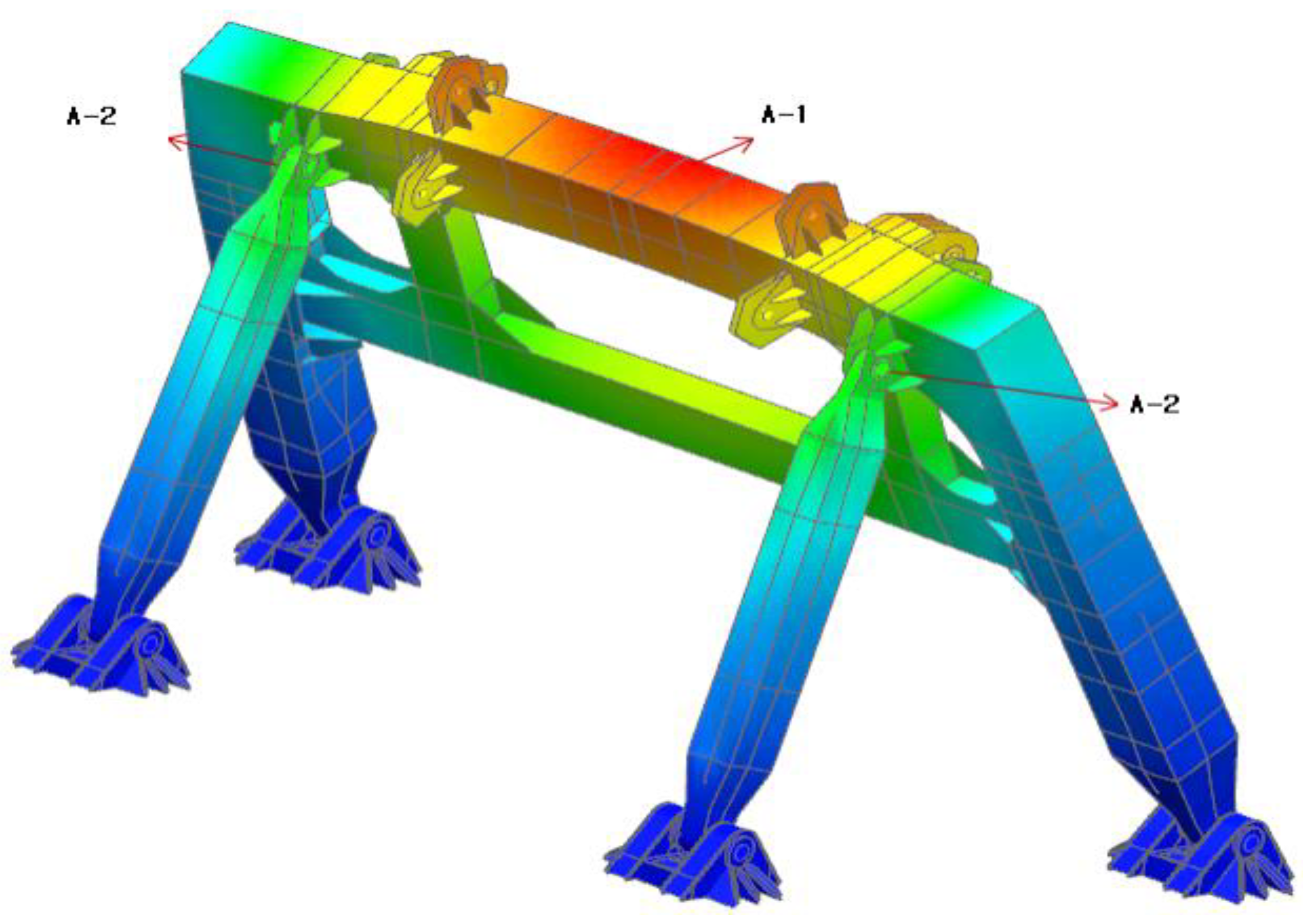

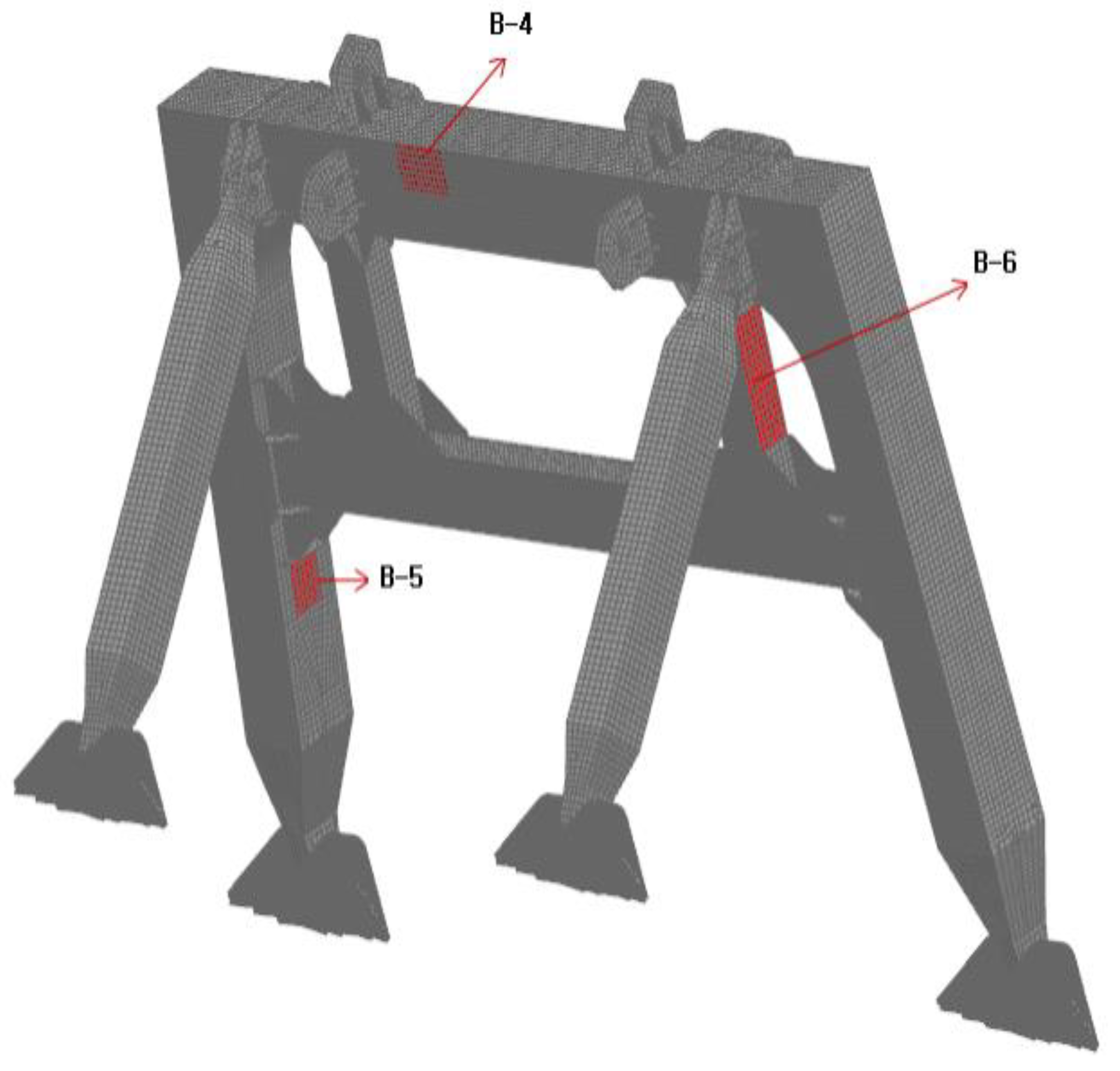
| Bridge Name | Bridge Type | Min Span Length (m) | Clearance under Bridge (m) |
|---|---|---|---|
| Youngjong | suspension | 300 | 40 |
| Seohae | cable stayed | 470 | 62 |
| Mokpo | cable stayed | 500 | 53 |
| Machang | cable stayed | 400 | 64 |
| Kwangyang | suspension | 1545 | 75 (85, center) |
| Bukhang | cable stayed | 540 | 60 |
| Ulsan | cable stayed | 560 | 60 |
| Geoga | cable stayed | 470 (main) 230 (sub) | 52 36 |
| Incheon | cable stayed | 800 | 70.4 |
| Capacity (ton) | Min. Luffing Angle (deg) | Boom Height (m) | Back Tower Height (m) | Remark |
|---|---|---|---|---|
| 120 | 50.5 | 50 | 22 | |
| 600 | 40 | 38 | - | Salko Co. |
| 1200 | 30 | 41.8 | 36.5 | Salko Co. |
| 2000 | 35 | 48 | 40 | Haekwan |
| 2200 | 40 | 56.1 | 34.5 | Kumyong |
| 3000 | 40 | 76.6 | 45 | SHI * |
| Height (m) | Velocity (m/s) | Shape Factor ( ) | Height Factor ( ) | Wind Pressure (Pa) |
|---|---|---|---|---|
| 18.1 | 16 | 1.2 | 1.1 | 207.2 |
| 30.9 | 16 | 1.2 | 1.2 | 226.0 |
| 42.8 | 16 | 1.3 | 1.2 | 244.9 |
| 49.2 | 16 | 1.3 | 1.2 | 244.9 |
| 51.9 | 16 | 1.4 | 1.3 | 285.7 |
| Height (m) | Velocity (m/s) | Shape Factor ( ) | Height Factor ( ) | Wind Pressure (Pa) |
|---|---|---|---|---|
| 18.1 | 25.8 | 1.2 | 1.1 | 538.7 |
| 30.9 | 25.8 | 1.2 | 1.2 | 587.7 |
| 42.8 | 25.8 | 1.3 | 1.2 | 636.7 |
| 49.2 | 25.8 | 1.3 | 1.2 | 636.7 |
| 51.9 | 25.8 | 1.4 | 1.3 | 742.8 |
| Height (m) | Velocity (m/s) | Shape Factor ( ) | Height Factor ( ) | Wind Pressure (Pa) |
|---|---|---|---|---|
| 14.0 | 16 | 1.3 | 1 | 204.0 |
| Height (m) | Velocity (m/s) | Shape Factor ( ) | Height Factor ( ) | Wind Pressure (Pa) |
|---|---|---|---|---|
| 14.0 | 25.8 | 1.3 | 1 | 530.6 |
| No. | Design Load |
|---|---|
| A | Safe working load of the crane 250 t |
| B | Safe working load of the crane 100 t |
| C | Additional impact loads |
| D | Self-weight of crane system and fittings attached |
| E | Self-weight of loose gear |
| F | Friction of cargo blocks |
| G | Wind loading 16 m/s, service conditions |
| H | Wind loading 25.8 m/s, stowage conditions |
| I | Loads due to ship inclination in service conditions |
| J | Loads due to ship inclination in stowage conditions |
| K | Loads due to ship motion + 0.5 g (Z-dir.), 0.25 g in the longitudinal direction (X-dir.) |
| L | Loads due to ship motion + 0.5 g (Z-dir.), 0.25 g in the transverse direction (Y-dir.) |
| M | Cylinder force (100 × 4 = 400 t) |
| N | Force of the upper sheave of back tower |
| O | Self-weight of back tower |
| No. | Combined Load Conditions (CLC) | ||||||
|---|---|---|---|---|---|---|---|
| CLC1 | CLC2 | CLC3 | CLC4 | CLC5 | CLC6 | CLC7 | |
| A | ● | ● | |||||
| B | ● | ● | |||||
| C | ● | ● | ● | ● | |||
| D | ● | ● | ● | ● | ● | ● | ● |
| E | ● | ● | ● | ● | ● | ● | ● |
| F | ● | ● | ● | ● | |||
| G | ● | ● | ● | ● | |||
| H | ● | ● | |||||
| I | ● | ● | ● | ● | |||
| J | ● | ● | |||||
| K | ● | ● | ● | ||||
| L | ● | ● | ● | ||||
| M | ● | ||||||
| No. | Combined Load Conditions | ||||||
|---|---|---|---|---|---|---|---|
| CLC1 | CLC2 | CLC3 | CLC4 | CLC5 | CLC6 | CLC7 | |
| N | ● | ● | ● | ● | ● | ● | ● |
| O | ● | ● | ● | ● | ● | ● | ● |
| G | ● | ● | ● | ● | ● | ||
| H | ● | ● | |||||
| I | ● | ● | ● | ● | |||
| J | ● | ● | |||||
| K | ● | ● | ● | ||||
| L | ● | ● | ● | ||||
| Load Condition | Mat. | Kind of Stress | |||
|---|---|---|---|---|---|
| Tension | Shear | Compression | Combined | ||
| CLC 1–4 | AH32 | 242.6 | 141.8 | 211.1 | 280.4 |
| CLC7 | AH36 | 273.6 | 159.8 | 237.9 | 316.0 |
| CLC 5–6 | AH32 | 274.1 | 157.5 | 239.4 | 315.0 |
| AH36 | 308.9 | 177.5 | 269.8 | 355.0 | |
| 0 | 1 | 2 | 3 | 4 | 5 | 6 | 7 |
|---|---|---|---|---|---|---|---|
| Boom | 145.3 | 148.6 | 100.7 | 115.7 | 149.9 | 201.8 | 166.8 |
| Back tower | 157.8 | 144.4 | 103.4 | 90.1 | 77.9 | 69.0 | 162.9 |
| Pos.no | B-1 | B-2 | B-3 | B-4 | B-5 | B-6 |
|---|---|---|---|---|---|---|
| a (mm) | 2650 | 3000 | 1200 | 1000 | 830 | 1816 |
| b (mm) | 1200 | 752 | 397 | 544 | 585 | 585 |
| t (mm) | 18 | 16 | 14 | 30 | 16 | 16 |
| fmat | 0.72 | 0.78 | 0.78 | 0.78 | 0.78 | 0.78 |
| σeq | 44.9 | 63.9 | 72.1 | 63.3 | 58.4 | 43.4 |
| σc | 162.4 | 306.2 | 287.0 | 305.4 | 274.6 | 295.9 |
| λ | 3.620 | 4.790 | 3.979 | 4.826 | 4.705 | 6.825 |
| check | OK | OK | OK | OK | OK | OK |
| Pos.no | B-1 | B-2 | B-3 | B-4 | B-5 | B-6 |
|---|---|---|---|---|---|---|
| 45.4 | −63.0 | 75.0 | −1.9 | −58.9 | −43.9 | |
| 1.1 | 1.8 | 6.1 | −64.2 | −1.1 | −1.1 | |
| 3.2 | 5.9 | 3.2 | −0.6 | −7.3 | 0.6 | |
| 164.4 | 2778.8 | 922.0 | 77.2 | 619.6 | 1317.1 | |
| 4 | −79.4 | 75.0 | 2608.8 | 11.6 | 33.0 | |
| 165.89 | 165.02 | 175.93 | 172.72 | 174.09 | 171.96 | |
| Equation (5) | 0.423 | 0.0064 | 0.0377 | 0.0034 | 0.055 | 0.0062 |
| check | OK | OK | OK | OK | OK | OK |
Publisher’s Note: MDPI stays neutral with regard to jurisdictional claims in published maps and institutional affiliations. |
© 2021 by the authors. Licensee MDPI, Basel, Switzerland. This article is an open access article distributed under the terms and conditions of the Creative Commons Attribution (CC BY) license (https://creativecommons.org/licenses/by/4.0/).
Share and Cite
Lee, M.-W.; Lee, J.-H.; Lee, Y.-S.; Park, H.-J.; Lee, T.-K. Safety Assessment for Upper Part of Floating Crane Considering Minimum Luffing Angle. Appl. Sci. 2021, 11, 5104. https://doi.org/10.3390/app11115104
Lee M-W, Lee J-H, Lee Y-S, Park H-J, Lee T-K. Safety Assessment for Upper Part of Floating Crane Considering Minimum Luffing Angle. Applied Sciences. 2021; 11(11):5104. https://doi.org/10.3390/app11115104
Chicago/Turabian StyleLee, Min-Woo, Ji-Hyun Lee, Yeon-Seung Lee, Hyun-Jin Park, and Tak-Kee Lee. 2021. "Safety Assessment for Upper Part of Floating Crane Considering Minimum Luffing Angle" Applied Sciences 11, no. 11: 5104. https://doi.org/10.3390/app11115104






